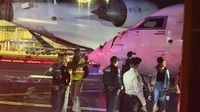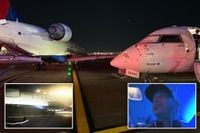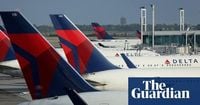On the night of October 1, 2025, the usually bustling taxiways of New York’s LaGuardia Airport were the scene of a dramatic and unsettling event: two regional jets operated by Delta Air Lines’ subsidiary Endeavor Air collided, damaging both aircraft and injuring a flight attendant. The incident, which occurred just before 10 p.m., has since drawn national attention and renewed concerns about aviation safety, especially as it happened during the first 24 hours of a federal government shutdown.
According to statements from Delta, the Federal Aviation Administration (FAA), and the Port Authority of New York and New Jersey, the collision unfolded as one Bombardier CRJ-900 jet, operating as Endeavor Air Flight 5155 and carrying 32 people, was preparing for takeoff to Roanoke, Virginia. At the same time, another CRJ-900, Flight 5047, was arriving from Charlotte, North Carolina, with 61 people aboard and was heading to a gate. The departing plane’s wing clipped the fuselage—and more specifically, the nose and cockpit—of the arriving jet at the intersection of two taxiways.
Passengers and crew were jolted by the impact. “Suddenly, we felt two big jolts,” said Thomas Hindman, a student pilot and passenger on the departing plane, in an interview with The New York Times. Joey Annunziato, a CBS News producer on the arriving flight, described the moment as “super-jarring,” adding, “Everyone shot forward in their seats and it was kind of a little chaotic as soon as it happened. We were shocked at what happened.”
Audio from air traffic control, posted by LiveATC.net, captured a pilot calmly reporting, “Their right wing clipped our nose and the cockpit. We have damage to our windscreen and ... some of our screens in here.” Images shared on social media and by news outlets showed the aftermath: a shattered cockpit windshield, a deeply gouged nose, and a large section of a wing torn off. Emergency vehicles rushed to the scene, and passengers described a tense period of silence before the pilot reassured them, “Hey, we’ve been in a crash, everyone remain calm.”
Miraculously, none of the passengers on either plane suffered injuries, but a flight attendant was not as fortunate. According to the Port Authority, she hit her knee during the collision and was subsequently taken to a hospital with non-life-threatening injuries. No further passenger injuries were reported, and Delta confirmed that all other customers and crew were safe.
The cause of the accident remains under investigation. The FAA said that air traffic control had instructed the Virginia-bound Flight 5155 to “hold short and yield to the other aircraft” prior to the incident. However, it is not yet clear why the collision occurred. The National Transportation Safety Board (NTSB) responded swiftly, dispatching a team of ten investigators to LaGuardia and recovering the flight recorders from both planes for detailed analysis at its Washington headquarters. The NTSB confirmed damage to the right wing of Flight 5155 and to the nose and windscreen of Flight 5047.
Former NTSB and FAA crash investigator Jeff Guzzetti, now an aviation safety consultant, explained to the Associated Press that while ground controllers direct planes on taxiways, pilots are responsible for maintaining situational awareness and avoiding other aircraft at slow speeds. “You’re supposed to have situational awareness about where your wings are poking out at and what they could hit as you’re taxiing,” Guzzetti said. He noted that the collision occurred at night, a time when pilots often turn off nose lights to avoid blinding others, potentially reducing visibility.
LaGuardia is among 35 major U.S. airports equipped with advanced surface radar systems designed to track aircraft and vehicles on the ground and alert controllers to potential conflicts. However, it is unclear whether this system played a role in the events leading up to the crash. Guzzetti pointed out that these systems are primarily intended to prevent runway collisions, not necessarily those on taxiways.
The timing of the incident has also raised questions about the impact of the ongoing federal government shutdown. The collision occurred within the first day of the shutdown, which has forced many federal employees, including some at the FAA, to work without pay or be furloughed. Airlines had previously warned that such a shutdown could strain the aviation system and potentially slow flights, as air traffic controllers—considered essential workers—continue to work but with reduced support staff. However, it remains unclear whether staffing levels at LaGuardia were affected at the time of the collision.
In the immediate aftermath, Delta moved quickly to care for affected passengers. Those on both flights were provided meals, hotel rooms, and rebooked on flights departing the next day. Some, like Thomas Hindman, received additional compensation, including a $1,000 travel voucher and a promise of a full refund. Passengers were transported by bus to the terminal after police and firefighters completed their inspections of the damaged aircraft, and many did not disembark until close to midnight.
Delta released a statement expressing regret and pledging full cooperation with authorities. “Delta will work with all relevant authorities to review what occurred as safety of our customers and people comes before all else. We apologize to our customers for the experience,” the airline said. The company added that both jets involved were operated by Endeavor Air and could seat between 70 and 90 passengers, though neither was at full capacity during the incident.
The LaGuardia collision comes amid heightened concerns about aviation safety in the United States, following several recent near misses and accidents, including the deadliest U.S. plane crash in decades earlier this year. A persistent shortage of air traffic controllers has been cited as a contributing factor in several incidents nationwide, and the current shutdown threatens to stall efforts to hire and train new controllers—a process the FAA had hoped to accelerate in the coming years.
For passengers like Hindman, the experience was unnerving. “I wasn’t leaning back in my seat, like, ‘Oh, the pilot’s got this,’” he admitted to The New York Times. “I was a little more on edge.”
As investigations by the NTSB and FAA continue, many in the industry and the flying public are watching closely, awaiting answers about how such a collision could occur on the ground at one of the nation’s busiest airports—and what steps will be taken to prevent similar incidents in the future.
The events at LaGuardia serve as a stark reminder of the complexities and risks of modern air travel, and the critical importance of maintaining robust safety systems even amid external pressures like government shutdowns and staffing shortages.


